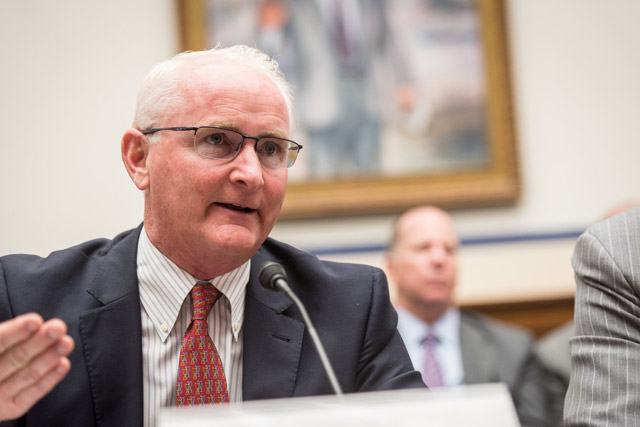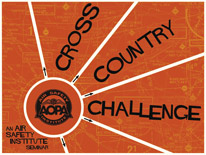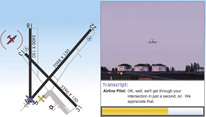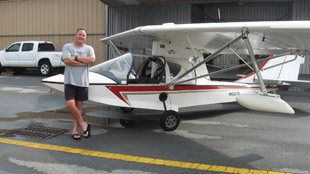Baker tells head of House transportation committee

AOPA President Mark Baker met with the head of the House Transportation and Infrastructure Committee to discuss FAA reauthorization and the critical issues affecting general aviation.
During a meeting with Rep. Bill Shuster (R-Pa.), Baker reiterated AOPA’s position that user fees on GA are not acceptable and that the current system of fuel taxes is an efficient and fair way to fund the FAA. Shuster chairs the committee, which is tasked with drafting FAA reauthorization legislation to set long-term spending priorities for the agency. The current FAA funding package expires September 30.
“The fuel tax system we already have in place is effective and cost-efficient. It works and we believe it’s the right way to fund aviation going forward,” said Baker. “We know from the experience of other nations that user fees can stifle general aviation, restrict access to airports and airspace, and prevent pilots from using the safety services they need—and that’s why AOPA won’t support user fees in any form.”
Reauthorization legislation typically addresses a broad range of issues affecting the FAA. The upcoming legislation could address not only the dollar amount and mechanism for funding the aviation system, but also medical and certification reforms, and even the FAA’s organizational structure. Shuster said he intends to introduce legislation to remove the air traffic organization from the FAA and establish a not-for-profit corporation to modernize the system.
“We haven’t seen the legislation and can’t say with certainty what it might contain,” said Baker. “I think almost everyone agrees the FAA is need of an overhaul in many areas, but it’s vital that any changes protect the interests of all system users, including GA, while ensuring the highest levels of safety. We’ll weigh in on those issues once the legislation is released, but in the meantime we are making it absolutely clear that we won’t accept user fees.”
AOPA has been actively involved in the ongoing FAA reauthorization debate. Baker has testified at several House and Senate hearings and roundtables on reauthorization issues. He also has met with key lawmakers, including Shuster, to ensure that the needs of the GA community are understood and addressed.
Survey: 46% of AOPA members believe Congress has a negative view of general aviation.
Cirrus is new corporate sponsor
AOPA has welcomed Cirrus Aircraft as a supporting sponsor. Cirrus Aircraft is the first GA aircraft manufacturer to participate in the AOPA Corporate Partnership program.
Known for its all-composite, glass-panel, parachute-equipped aircraft, Cirrus sponsored a number of events at AOPA’s regional fly-ins. Cirrus will continue to host fly-in receptions and supply aircraft for future aircraft displays.
“We’re proud to partner with Cirrus, one of the nation’s most innovative aircraft manufacturers,” said Jiri Marousek, AOPA senior vice president of marketing. “Cirrus is strongly committed to performance, safety, and advancing GA. Those principles fit perfectly with AOPA’s core mission to protect our freedom to fly and to continue to improve aviation safety.”
“Cirrus Aircraft’s mission is to continue enhancing the aviation experience for aircraft owners, pilots, and enthusiasts around the world,” said Ben Kowalski, Cirrus Aircraft vice president of marketing. “Partnering with AOPA is a natural step forward as we continue to innovate in GA, bringing new aircraft, services, and experiences to aviators everywhere.”
Cirrus Aircraft is AOPA’s latest Supporting Sponsor in AOPA’s Corporate Partnership Program, joining Sporty’s Pilot Shop and DTC Duat. Strategic Partners include Aero-Space Reports, Aircraft Spruce & Specialty Co., Bank of America, Breitling, and Enterprise Holdings (Enterprise, National, Alamo); Premier Partners include Jeppesen and PilotWorkshop.com.
Action in the States
Alaska Region
AOPA is working with the Alaska Airmen Association to bring attention to pilot concerns in the state. The groups hosted sessions with the Alaska congressional delegation and state officials in Anchorage. Sen. Lisa Murkowski (R-Alaska), Sen. Dan Sullivan (R-Alaska), and Rep. Don Young (R-Alaska) were joined by Alaska Department of Transportation Commissioner Marc Luiken. Topics included third class medical reform, ADS-B implementation, lack of weather reporting, federal overreach, user fees, military airspace, proposed landing fees, and 100LL fuel availability.
Northwest Mountain Region
Oregon Gov. Kate Brown signed an AOPA-backed bill to protect private airfield owners in the state from liability. Under the new law, the owner of land is not liabile for injury, death, or property damage resulting from the use of the land for aviation activity. AOPA joins the Colorado Pilots Association, the Seaplane Pilots Association, and others in an effort to modify the Colorado Division of Parks and Wildlife’s existing ban on seaplane operations on state waters, which has led to a de facto ban on seaplanes statewide.
Western Pacific Region
In Nevada, AOPA-supported S.B.514, which appropriates $100,000 for enlargement, improvement, or maintenance of rural airports, landing areas, or air navigation facilities in the state. It has been signed into law by Gov. Brian Sandoval. In California, AOPA’s Rusty Pilots program, which is designed to help lapsed pilots get back into the left seat, is taking off. AOPA Ambassador Kay Sundaram reports that this program was well received at many airports, with more to come this summer.
Central Southwest Region
AOPA Regional Manager Yasmina Platt has been traveling throughout Texas, spreading the message that GA is accessible, safe, and fun. Nebraska Gov. Pete Ricketts recently signed two GA-friendly bills. The first will reduce the tangible personal property tax on any property that produces income, to include aircraft used for business. The second adds an enforcement provision and improves the marking requirements of existing meteorological evaluation tower legislation.
AOPA regional managers from across the nation gathered in Washington, D.C., in June to discuss advocacy strategies.
Great Lakes Region
AOPA Regional Manager Bryan Budds has been urging state senators to protect Ohio’s Airport Fund from plans to divert fund revenue to economic development projects unrelated to aviation. In Michigan, Budds met with airport management, pilots, and community members at Sparta Municipal Airport. In Aurelius Township Budds met with officials urging them to reconsider their decision to issue permits for a communications tower on the approach path to a privately owned, private use airport.
Southern Region
South Carolina has passed an AOPA-supported tax exemption on aircraft maintenance, parts, and labor. The new law takes effect January 1, 2016. The Central Florida Flying Club, the first club formed with direct assistance from AOPA’s new You Can Fly initiative, continues to make progress and grow its membership. Its motto is; “Fly more, spend less, have fun.” The club has dedicated itself to helping nonpilots find their way to the cockpit and providing existing pilots a social structure that will enhance their recreational pursuits.
NorthEast Region
In Massachusetts, Regional Manager Sean Collins submitted testimony opposing sections of S.B.1453, aimed at repealing sales and use tax exemptions on the purchase and storage of aircraft. Collins participates in the New York State Airport System Plan update process, taking part in the Study Advisory Forum. In New Hampshire, he took part in the most recent quarterly meeting of the Granite State Airport Management Association, where he shared AOPA’s perspective on key issues affecting GA.
AOPA Pilot Protection Services
Visits to health professionals
Answering question 19
By Dr. Warren O. Silberman
Over the years I have had many questions about Question 19, “Visits to Health Professional Within Last Three Years,” on the FAA medical application, specifically regarding what information to input and how.
You are asked to insert all visits to health professionals within the past three years. Notice the date requirement requests only the month and the year. If you have forgotten the exact month, use January. The form then requests the reason for the visit. This is probably the most important block in that section that the FAA is interested in. You should be as specific as possible.
One of the common problems is with skin cancers. Do not just put “remove skin cancer.” This will surely lead to a request for more information from the FAA. Be very specific. For example, a basal cell skin cancer is associated with sun exposure and in general is cured by surgical removal. A malignant melanoma is one of the most serious of skin cancers and can spread to the brain.
A very common question is, “What if I see a physician many times, how should I list those?” I tell my airmen that as long as the visit is for the same medical problem, you can just list it once. Use the date of the most recent visit and in the “Reason for Visit” section, write, “multiple visits for blood pressure treatment” or “multiple visits for prostate cancer treatment,” et cetera.
I am also asked how the FAA defines “health professionals.” If you click on the question mark icon next to the item on the MedXPress application, you will see the instructional guidance for that question. There is a short list of health professionals, which includes “physicians, physician assistant, nurse practitioner, psychologist, clinical social worker, or substance abuse specialist for treatment, examination, or medical/mental evaluation.” However, the guidance also states that other consultations with an employee assistance program for some mental health issues may be excluded unless they pertain to psychiatric treatment or substance abuse. It is then the burden of your aviation medical examiner to question you and obtain more information, although the FAA will send you the request for more documentation if it is not happy with your response.
Dr. Warren O. Silberman is the former manager of FAA Aerosapce Medical Certification. Learn more about AOPA Pilot Protection Services.
Answers for Pilots
Aircraft refurbishing webinar: Did you miss it?
Hundreds of aircraft owners joined AOPA for a recent webinar on refurbishing aircraft. AOPA editors Tom Haines and Dave Hirschman shared the experience and expertise they’ve gained from multiple aircraft overhauls, rebuilds, and upgrades. They covered what makes some airplanes better candidates for refurbishing than others, where and how to start, what jobs to tackle, and how to find resources that fit your project. If you missed it, you can watch the recording at this link. Brought to you by AOPA Insurance Services and AOPA Aviation Finance Company, LLC.
AOPA AD&D Protection Plan
24/7 protection for you and your family
As an AOPA member you have exclusive, guaranteed access to AOPA Accidental Death and Dismemberment Insurance benefits that would protect you and your family in case of an accident, whether you are at home, in the air, at work, or on the go.
These benefits protect you anywhere, 24/7, and they have no aviation exclusions. With the AOPA AD&D Protection Plan you can be sure that you have coverage designed to fit your lifestyle, regardless of how often you may fly.
To find out more about what the AOPA AD&D Protection Plan can provide to you and your family, visit the website (aopainsurance.org/add) or call 877-432-2672.
AOPA Foundation
The Air Safety Institute’s goal is to ensure pilots have a wealth of information to keep flying safely, with free aviation safety educational programs. But we can’t do it without your support. Please consider advancing that mission—donate to the AOPA Foundation today (www.aopafoundation.org/donate).
Air Safety Institute
Go on a ‘Cross-Country Challenge’ with our new fall seminar
 When we talk about safety, we normally tackle one issue at a time—thunderstorms one day, taxi clearances the next. But in the real world, any given flight can bring together a whole range of interconnected safety issues:
When we talk about safety, we normally tackle one issue at a time—thunderstorms one day, taxi clearances the next. But in the real world, any given flight can bring together a whole range of interconnected safety issues:
• Fly through that precipitation—or deviate and cut into my fuel reserve?
• Climb above that scattered layer—or risk airsick passengers?
• Fly with an underinflated nose strut—or delay and fly in worse weather?
This free seminar reflects that reality. You’ll follow along with the seminar leader “flying” two fictional trips while debating questions and answers along the way. From preflight planning to tiedown technique, if it’s related to the flight, it’s fair game!
On the web: Cross-Country Challenge runs from August 25 to November 5. Visit the website for dates and locations near you.
‘Heads Up’ to improve runway safety
Lessons learned from a 1996 runway collision
 A few minutes after sunset, a Beech 1900 regional airliner inbound for Runway 13 at Quincy Airport in Quincy, Illinois, announced a six-mile final, while a Beech King Air was preparing to take off from Quincy’s Runway 4. Behind the King Air was a new private pilot waiting his turn to depart in a Piper Cherokee. But a combination of inattention and inappropriate—although well-intentioned—communication started a chain of events that ended with a collision and 14 fatalities.
A few minutes after sunset, a Beech 1900 regional airliner inbound for Runway 13 at Quincy Airport in Quincy, Illinois, announced a six-mile final, while a Beech King Air was preparing to take off from Quincy’s Runway 4. Behind the King Air was a new private pilot waiting his turn to depart in a Piper Cherokee. But a combination of inattention and inappropriate—although well-intentioned—communication started a chain of events that ended with a collision and 14 fatalities.
Watch the short animation of this accident to understand how collisions on tarmacs, taxiways, and runways can happen when pilots lose situational awareness, make communication mistakes, or operate under incorrect assumptions—whether on the ground or approaching to land. Inexperience, being unfamiliar with an airport layout, taxiing in marginal visibility, and plain inattentiveness can all cause harm—even fatalities, as we can see from this accident.
We can improve our chances of avoiding such misfortunes by observing a sterile cockpit environment during critical phases of flight and completing checklists before moving on the airport surface areas. In addition, it’s imperative to pay careful attention to radio communication, especially when you’re operating at a nontowered airport. When visibility is good, look what’s going on outside the cockpit window—on the runways and in the air.
This seminar is brought to you by AOPA Insurance Services.
‘Operations at Airports’ spotlighted
 Of the more than 5,000 public-use airports in the United States, most are categorized as nontowered, while there are some 600 airports that have an operating air traffic control tower. Depending on where you learned to fly, you may feel anxious to operate in an unfamiliar environment.
Of the more than 5,000 public-use airports in the United States, most are categorized as nontowered, while there are some 600 airports that have an operating air traffic control tower. Depending on where you learned to fly, you may feel anxious to operate in an unfamiliar environment.
Whether you’re new to these environments or just need a refresher, ASI’s Operations at Airports and Runway Safety spotlights will help you find just about everything on the topic in one easy place.
The spotlights’ courses, videos, and publications will help you avoid confusion or unsafe situations by bolstering your knowledge about surface operations and flying to and from airports with and without a control tower. Learn how to effectively communicate with fellow pilots and ATC, and understand your responsibilities—and those of others operating nearby. Then take the safety quizzes to pull everything together. You’ll be comfortably prepared to effortlessly operate at any field, towered or not.
AOPA Finance
Buying a new ride
AOPA Aviation Finance made financing easy
 “I began flying as a kid,” says Tim Jones, whose father had an aerial advertising business doing banner towing, sky writing, and operating a night sign. “I was around interesting airplanes and interesting people. I earned my private pilot certificate right after college. I then began my career, relocated a couple of times, got married, and began a family.”
“I began flying as a kid,” says Tim Jones, whose father had an aerial advertising business doing banner towing, sky writing, and operating a night sign. “I was around interesting airplanes and interesting people. I earned my private pilot certificate right after college. I then began my career, relocated a couple of times, got married, and began a family.”
As such, he did not log a lot of PIC time but he did continue to fly with his father, who now had a Beech Baron and lived near him in Connecticut. Several moves later, now living in Atlanta, Jones decided to build an airplane as an affordable option for him to fly. He says, “I built a Progressive Aerodyne Searey amphibian, which I now have about 330 hours in.”
The Searey has been a great sport airplane and allowed for many flying adventures. His wife likes the Searey, but she has family in Texas and wanted an airplane that could haul them and their 72-pound yellow Lab to Texas for visits and to Florida for weekend getaways. “We decided that the Cessna 182 that we just purchased with the help of AOPA financial services best fit the bill for speed, comfort, and great useful load,” Jones says.
He chose AOPA to help finance the Cessna 182 in part because AOPA made it so easy. He would recommend AOPA Aviation Finance to anyone considering an airplane purchase. “I started on the website. Once I chose the aircraft best suited for our needs, I placed a call to AOPA Aviation Finance. The AOPA Aviation Finance team was very responsive and helped me understand the many options available to me. I was assigned a representative who then walked me step by step through the financing, paperwork, and closing. Kevin Show communicated with me the entire way through the process and kept everything moving,” he says. “I think that AOPA made it easy for me to find answers to all of the unknowns of buying an airplane. The website and friendly human resources made it pleasant and easy to buy an airplane.”
If you’re looking to finance an airplane, contact AOPA Aviation Finance at 800-62-PLANE or visit online. AAF’s friendly staff will speak your language and take the confusion out of buying an airplane. Don’t forget that using AOPA Aviation Finance not only helps you, but also helps AOPA in its mission to keep GA airports open and support your freedom to fly.


